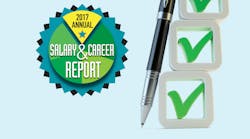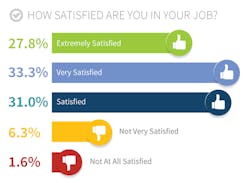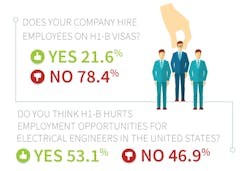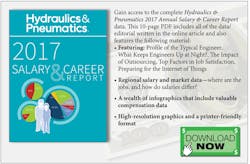Based on our survey of more than 1,000 fluid power engineers, more than 90% of respondents said they were satisfied in their current positions, and a similar percentage would recommend the profession to young people., In addition, the engineers have lots of strong opinions about formal education, team-building, and staying updated on relevant topics to further their engineering careers.
When asked whether a shortage of fluid power talent exists, some respondents suggested that colleges and institutions should increase students’ lab time and offer more opportunities for hands-on work to improve their success in STEM careers. Other responses noted the importance of learning how to apply engineering principles and industry standards during formal education. Apprenticeships and internships were also highlighted as key opportunities for students to build skills and relationships that could jumpstart their careers. About half of the respondents’ companies provide internship positions to college and high-school students.
“Engineering schools need to give students more opportunities to work on hand-on projects,” one respondent said. “The students need to learn to apply theory and math in reality to develop products or improve an apparatus or machines. Most curriculums don't have enough lab time.”
The Hydraulics & Pneumatics audience also shared how they stay up to date with their own education. Many respondents hold certifications as professional engineers, Six Sigma by Institute of Industrial Engineers, and IFPS Certified Fluid Power Specialist. Others were Certified Drafters and Certified Engineering Technicians. Fifty to 70% of respondents use resources like webcasts, online videos, articles, and whitepapers to stay up-to-date, while only 20-35% of respondents used online community forums or social media sites to find resources for information.
When prompted whether companies should be expected to provide comprehensive in-house training to entry-level workers, many respondents said that they should, while suggesting that formal education programs should also share responsibility by preparing students with application-based training based on their preferred field of study. Meanwhile, about half of the respondents’ companies provide mentoring programs for workers, while less than 10% use training consultants to train engineers before they start the job. This could mean that company employees are helping train entry-level workers on the job.
But survey results also show that entry-levels are indeed bringing new skills to their companies, including those in CAD/CAM modeling and simulation, 3D printing, and robotics and computer programming. One commenter noted that many entry-level workers are using more “social media techniques to collaborate and share information," while another recognized an “inherent intuition (among entry-level workers) for finding information nested deep in software programs.”
More than 60% of respondents said that their companies are hiring specialists for emerging technologies including electromechanics and electronic systems, themes in mechanical design, controls, automation, and predictive maintenance. Respondents see a potential for job growth in automation, machine monitoring and controls, and data gathering and analysis within the next 5 to 10 years.






